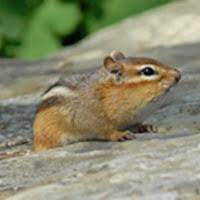APDG ~ Animal Series #10 - Chipmunks - November
Launch gallery slideshow

| Group: | Artistic Profile Deco Group ;-) |
| Swap Coordinator: | yvonne401 (contact) |
| Swap categories: | Nature Themed |
| Number of people in swap: | 4 |
| Location: | International |
| Type: | Type 1: Electronic |
| Last day to signup/drop: | November 14, 2022 |
| Date items must be sent by: | November 30, 2022 |
| Number of swap partners: | 3 |
| Description: | |
|
Chipmunks are small, striped rodents of the family Sciuridae. Chipmunks are found in North America, with the exception of the Siberian chipmunk which is found primarily in Asia. Chipmunks may be classified either as a single genus, Tamias, or as three genera: Tamias, of which the eastern chipmunk (T. striatus) is the only living member; Eutamias, of which the Siberian chipmunk (E. sibiricus) is the only living member; and Neotamias, which includes the 23 remaining, mostly western North American, species. These classifications were treated as subgenera due to the chipmunks' morphological similarities. As a result, most taxonomies over the twentieth century have placed the chipmunks into a single genus. However, studies of mitochondrial DNA show that the divergence between each of the three chipmunk groups is comparable to the genetic differences between Marmota and Spermophilus, so the three genera classifications have been adopted here. The common name originally may have been spelled "chitmunk", from the native Odawa (Ottawa) word jidmoonh, meaning "red squirrel" (cf. Ojibwe ᐊᒋᑕᒨ ajidamoo). The earliest form, from 1842, cited in the Oxford English Dictionary is "chipmonk", but "chipmunk" appears in several books from the 1820s and 1830s. Other early forms include "chipmuck" and "chipminck", and in the 1830s they were also referred to as "chip squirrels", probably in reference to the sound they make. In the mid-19th century, John James Audubon and his sons included a lithograph of the chipmunk in their Viviparous Quadrupeds of North America, calling it the "chipping squirrel [or] hackee". Chipmunks have also been referred to as "striped squirrels", "timber tigers", "minibears", and "ground squirrels" (although the name "ground squirrel" usually refers to other squirrels, such as those of the genus Spermophilus).[citation needed] Chipmunks have an omnivorous diet primarily consisting of seeds, nuts and other fruits, and buds. They also commonly eat grass, shoots, and many other forms of plant matter, as well as fungi, insects and other arthropods, small frogs, worms, and bird eggs. They will also occasionally eat newly hatched baby birds. Around humans, chipmunks can eat cultivated grains and vegetables, and other plants from farms and gardens, so they are sometimes considered pests. Chipmunks mostly forage on the ground, but they climb trees to obtain nuts such as hazelnuts and acorns. At the beginning of autumn, many species of chipmunk begin to stockpile nonperishable foods for winter. They mostly cache their foods in a larder in their burrows and remain in their nests until spring, unlike some other species which make multiple small caches of food. Cheek pouches allow chipmunks to carry food items to their burrows for either storage or consumption. Eastern chipmunks, the largest of the chipmunks, mate in early spring and again in early summer, producing litters of four or five young twice each year. Western chipmunks breed only once a year. The young emerge from the burrow after about six weeks and strike out on their own within the next two weeks. These small mammals fulfill several important functions in forest ecosystems. Their activities harvesting and hoarding tree seeds play a crucial role in seedling establishment. They consume many different kinds of fungi, including those involved in symbiotic mycorrhizal associations with trees, and are an important vector for dispersal of the spores of subterranean sporocarps (truffles) which have co-evolved with these and other mycophagous mammals and thus lost the ability to disperse their spores through the air. Chipmunks construct extensive burrows which can be more than 3.5 m (11 ft) in length with several well-concealed entrances.[The sleeping quarters are kept clear of shells, and feces are stored in refuse tunnels. The eastern chipmunk hibernates in the winter, while western chipmunks do not, relying on the stores in their burrows. Chipmunks play an important role as prey for various predatory mammals and birds but are also opportunistic predators themselves, particularly with regard to bird eggs and nestlings, as in the case of eastern chipmunks and mountain bluebirds (Siala currucoides). Chipmunks typically live about three years, although some have been observed living to nine years in captivity. Chipmunks are diurnal. In captivity, they are said to sleep for an average of about 15 hours a day. It is thought that mammals which can sleep in hiding, such as rodents and bats, tend to sleep longer than those that must remain on alert. Next onto our swap: Post THREE (3) pictures and/or gifs to each of your THREE (3) partner’s profiles with the theme “Chipmunks”. The pictures that you choose may be the SAME OR DIFFERENT between all of your partners. Please choose pictures that you think THEY will enjoy! If you get 3 pictures from your partner on “Chipmunks” you have to rate them a 5. The heart on the rating is for if you like what they sent. To leave a photo on someone's profile use this code ! [ ] ( Put image address here ) With NO spaces & paste the picture's link between the curved parentheses. Practice on your own profile first to be sure it looks good because you can easily delete it there. Pick images that are size 300 wide or smaller to be sure they fit. I go to Google images to get my pictures. Hover over images to see their size because there will be some larger sizes there too. If you really like something click on it and go to the words SEARCH BY IMAGE and click on that. THEN go to the word SMALL and see if there is one 300 size. There are other tricks in the group thread; AN EASY way to get a small PIC from a BIG one;-) You can find moving pictures at http://giphy.com/ Please write the TITLE OF THE SWAP ON YOUR PROFILE DECO MESSAGE too! This makes it easier for partners that are in a lot of these swaps to rate it. Requirements:
Be sure to rate your partner. Any problems, feel free to contact me. I want to thank @anrtist for allowing me to borrow SOME of her wording. | |
Discussion
Leave a Comment
You must be logged in to leave a comment. Click here to log in.
- Info:
- Home
- |
- About
- |
- Forum Rules
- |
- Terms of Use
- |
- Press
- |
- Advertising
- |
- Blog
- |
- Graphics & Stuff
- Help:
- New User Info
- |
- FAQ
- |
- Group Info
- |
- Glossary
- |
- Forums
- |
- |
- Contact Admin

